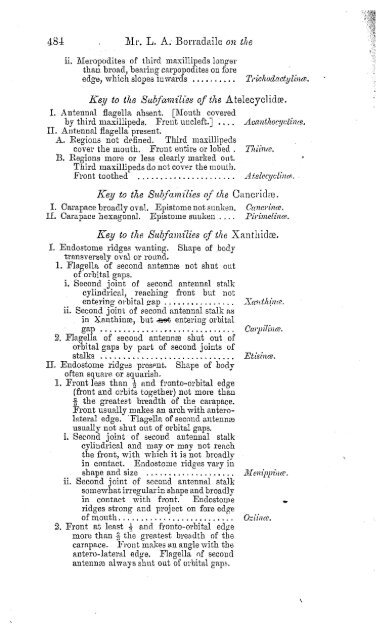On the Classification of the Decapod Crustaceans. By L. A. ...
On the Classification of the Decapod Crustaceans. By L. A. ...
On the Classification of the Decapod Crustaceans. By L. A. ...
Create successful ePaper yourself
Turn your PDF publications into a flip-book with our unique Google optimized e-Paper software.
484 Mr. L. A; Borradaile on <strong>the</strong><br />
ii. Meropodites <strong>of</strong> third maxillipeds longer<br />
than broad, bearing' carpopodites on fore<br />
edge, which slopes inwards<br />
Trichodactylaw.<br />
Key to <strong>the</strong> Subfamilies <strong>of</strong> <strong>the</strong> Atelecyclida?.<br />
I. Antennal flagella absent. [Mouth covered<br />
by third maxillipeds. Front uncleft.] .... Acanthoci/clince.<br />
II. Antennal flagella present,<br />
A. Eegions not denned. Third maxillipeds<br />
cover <strong>the</strong> mouth. Front entire or lobed . Thiirue.<br />
B. Regions more or less clearly marked out.<br />
Third maxillipeds do not cover <strong>the</strong> mouth.<br />
Front too<strong>the</strong>d<br />
Atelecy clinch.<br />
Key to <strong>the</strong> Subfamilies <strong>of</strong> <strong>the</strong> Cancridce.<br />
I. Carapace broadly oval. Epistome not sunken. Cancrince.<br />
II. Carapace hexagonal. Epistome sunken .... Pirimelince.<br />
Key to <strong>the</strong> Subfamilies <strong>of</strong> <strong>the</strong> Xanthidce.<br />
I. Endostome ridges wanting. Shape <strong>of</strong> body<br />
transversely oval or round.<br />
1. Flagella <strong>of</strong> second antennse not shut out<br />
<strong>of</strong> orbital gaps.<br />
i. Second joint <strong>of</strong> second antennal stalk<br />
cylindrical, reaching front but not<br />
entering orbital gap<br />
XantAmce.<br />
ii. Second joint <strong>of</strong> second antennal stalk as<br />
in Xanthine, but -set entering orbital<br />
gap<br />
Carpilince.<br />
2. Flagella <strong>of</strong> second antennce shut out <strong>of</strong><br />
orbital gaps by part <strong>of</strong> second joints <strong>of</strong><br />
stalks<br />
Etisinee.<br />
II. Endostome ridges present. Shape <strong>of</strong> body<br />
<strong>of</strong>ten square or squarish.<br />
1. Front less than | and fronto-orbital edge<br />
(front and orbits toge<strong>the</strong>r) not more than<br />
f <strong>the</strong> greatest breadth <strong>of</strong> <strong>the</strong> carapace.<br />
Front usually makes an arch with anterolateral<br />
edge. 'Flagella <strong>of</strong> second antenna?<br />
usually not shut out <strong>of</strong> orbital gaps,<br />
i. Second joint <strong>of</strong> second antennal stalk<br />
cylindrical and may or may not reach<br />
<strong>the</strong> front, with which it is not broadly<br />
in contact. Endostome ridges vary in<br />
shape and size<br />
Maiippinee.<br />
ii. Second joint <strong>of</strong> second antennal stalk<br />
somewhat irregularin shape and broadly<br />
in contact with front. Endostome „<br />
ridges strong and project on fore edge<br />
<strong>of</strong> mouth<br />
Oziince.<br />
2. Front at least i and fronto-orbital edge<br />
more than £ <strong>the</strong> greatest breadth <strong>of</strong> <strong>the</strong><br />
carapace. Front makes an angle with <strong>the</strong><br />
antero-lateral edge. Flagella nf second<br />
antennas always shut out <strong>of</strong> orbital gap.?.
















